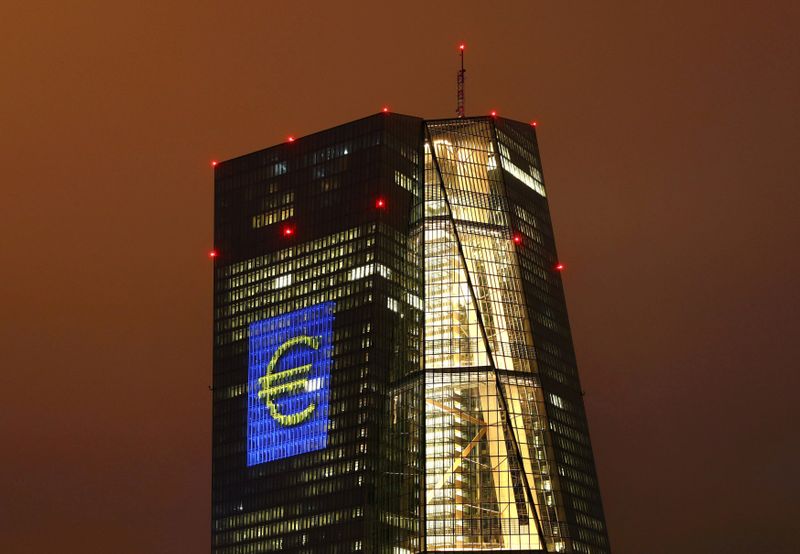LONDON (Reuters) – The European Central Bank meets on Thursday, the ink barely dry on its emergency bond-buying scheme, and markets are already asking what more it will do to help the euro zone economy through the coronavirus crisis.
Its emergency stimulus, which puts it on course to buy 1.1 trillion euros of bonds in 2020, halted a pandemic-induced financial rout in March that heightened fears about the 19-country currency bloc’s viability.
As the world grapples with the worst recession in decades and borrowing costs in virus-stricken members such as Italy rise again, the battle for policymakers is far from over — not least as European governments struggle to agree details of their own emergency stimulus plan.
“The ECB has already done a lot but this will be a key meeting in trying to explain what its exact strategy is,” said Nick Kounis, head of financial markets research at ABN AMRO.
Here are five key questions for markets.
1. Is the 1.1 trillion euros set aside for bond purchases this year enough?
Market watchers suspect the ECB will have to expand asset purchases given the ballooning government debt issuance required to finance spending to contain the coronavirus fallout.
ABN AMRO estimates that euro area government funding needs have risen by an additional 690 billion euros. The ECB is undertaking 750 billion euros of emergency purchases on top of the 120 billion euros of purchases added to its conventional bond-buying scheme in March. With around 60-65% of this going towards sovereign debt, ABN says increased purchases will not be enough to cover additional debt issued.
A front-loading of asset purchases to help vulnerable peripheral states also suggests the ECB may need to top up its emergency scheme soon.
At the current daily pace emergency ECB bond buys will be exhausted by October, two banks estimate. Even hawkish policymakers such as the Netherlands’ Klaas Knot are not ruling out an increase in emergency bond purchases.
For an interactive version of the below chart, click here https://reut.rs/2XVvBso.
Graphic – How long can the ECB’s PEPP last?: https://fingfx.thomsonreuters.com/gfx/editorcharts/oakvebnmprd/eikon.png
2. What other measures could the ECB take?
The ECB appears willing to take additional measures after saying last week that it would lend against some junk assets.
“That’s really a huge step, because the ECB has never wanted to accept junk at all,” said Piet Haines Christiansen, chief strategist, ECB and fixed income, at Danske Bank.
Next, the ECB could extend the collateral allowance to all higher-rated junk debt and make outright purchases of debt from newly downgraded “fallen angels”, ING analysts said.
Other options include buying exchange-traded funds, bank bonds, offering even more favourable terms on cheap multi-year bank loans and increasing the multiplier on the ECB’s tiered rate. This exempts banks from taking an effective penalty due to negative interest rates for their excess reserves at the ECB.
Pictet Wealth Management’s global strategist Frederic Ducrozet reckons the multiplier could increase to eight times excess reserves, from the current six times.
Graphic – The ECB’s QE programme: https://fingfx.thomsonreuters.com/gfx/mkt/jbyprzmzpeo/Pasted%20image%201587639824484.png
3. How deep will the recession be, and how quick the recovery?
The ECB is bracing for a “large contraction” in economic growth. Markets, trying to assess whether more stimulus is coming soon, want details on how policymakers see the recovery playing out.
Faced with an unparalleled shutdown in economic activity to contain the coronavirus, forecasting the recovery is challenging. A Reuters polls shows economists’ forecasts for 2020 growth range from 0% to minus 16.1%.
“I am more interested in how the ECB sees the shape of the recovery — the important question is if we get growth in the third and fourth quarters,” said AXA Investment Managers chief economist Gilles Moec.
For interactive versions of the below charts, click here https://tmsnrt.rs/2Vuox4j.
Graphic – Shapes of recovery: https://fingfx.thomsonreuters.com/gfx/editorcharts/dgkplrkbpbx/eikon.png
4. How concerned is the ECB about increased non-performing loans?
The Bank of Italy has warned the coronavirus crisis could drive up the share of bank loans turning sour. Unease is also rising in Portugal, where the non-performing loan (NPL) ratio for banks fell to 6.1% of total credit in December, from 17.9% in mid-2016, but remains about twice the European average.
Having eased collateral requirements and offered generous terms on cheap loans to support banks, the ECB may now be asked whether it is prepared to buy NPLs.
For some economists, transferring NPLs created during the pandemic to the ECB balance sheet would send a powerful message. But they stress this is complicated by the ECB’s bank supervisory role.
“The longer the crisis lingers, the greater the risk that loans might never recover,” said Marie Owens Thomsen, global chief economist at Indosuez Wealth Management. “I cannot see the ECB buying NPLs. But, in its role as banking supervisor, it can certainly exert pressure on banks to tackle their own issues.”
For an interactive version of the below graphic, click here https://tmsnrt.rs/3eU0J1w.
Graphic – Euro zone bad loans: https://fingfx.thomsonreuters.com/gfx/editorcharts/ygdvzzngvwa/eikon.png
5. Could the ECB give clarity on what it’s buying under emergency bond purchases?
The ECB publishes a breakdown of bond purchases for its quantitative easing programme but not for its Pandemic Emergency Purchase Programme. It could be pressed for more clarity.
Greater transparency on the PEPP could help shore up confidence in Italy’s bonds, whose yields are rising again.
“In the current environment of elevated economic, financial and political uncertainty, we fear that the lack of transparency about PEPP purchases could fuel conspiracy theories about the ECB’s support, or lack thereof,” said Pictet’s Ducrozet.
The ECB may also be asked whether it could change its mind about reinvesting funds from maturing bonds bought under PEPP.
Doing so could have a significant impact on Italian bonds and reduce the need for the ECB to scale Italian debt purchases to contain rising borrowing costs, said AXA’s Moec.
Graphic – Italian-German bond spread: https://fingfx.thomsonreuters.com/gfx/mkt/rlgpdrxwpoj/Pasted%20image%201587640092450.png
(Reporting by Dhara Ranasinghe and Yoruk Bahceli; Graphics by Ritvik Carvalho; Editing by Tommy Wilkes and Catherine Evans)
















